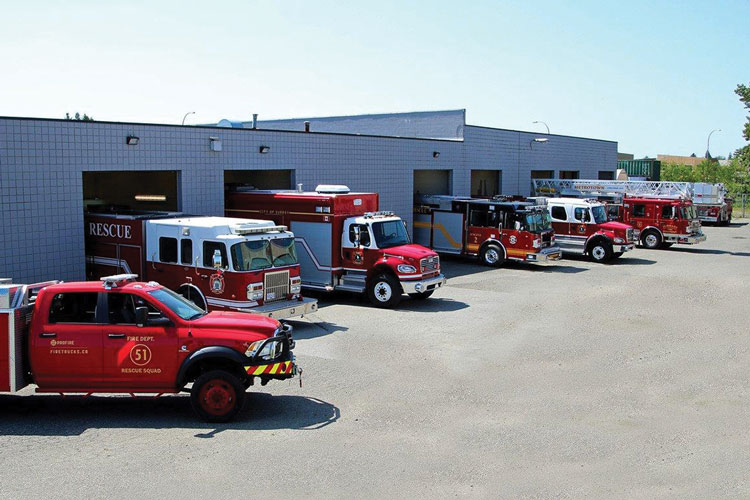
By Bill Adams
Despite a 5,500-mile shared border and a feeling of commonality between the United States and Canada, there are significant differences in the two countries and, in particular, in the fire apparatus market.
The apparatus manufactured in each country may look alike, but there are subtle differences in regulatory standards as well as significant differences in how business is conducted. They must be explained to better understand one of Canada’s largest apparatus dealers, Safetek Emergency Vehicles, Ltd.
 |
| 1 John Witt says Safetek is in the design/build process of replacing its existing offices in Abbottsford, British Columbia. (Photos courtesy of Safetek Emergency Vehicles, Ltd.) |
According to geography textbooks, Canada is one of the four largest countries in the world in land mass. It is just behind the United States’s 3.85 million square miles. Canada’s population is slightly more than 10 percent of the approximately 324 million inhabitants in the United States. The Canadian Parliament formally recognizes English and French as co-official languages of the country, and governmental business can be conducted in either. There are also more than four dozen distinctive languages as well as native dialects spoken throughout the country. That, in itself, can be challenging for fire truck vendors.
Amalgamation
I believe any merging and consolidation of American fire departments was, and is, self-imposed and initiated by the fire departments themselves because of inadequate staffing, financial constraints, and a desire to improve customer service. In the mid 1990s, the Canadian government encouraged amalgamation – the consolidation of municipal services and governments. My observation as a “foreigner” is that some Canadian fire departments have been forced into consolidation by edict. I am not disparaging the Canadian fire service. It is my opinion that the early merging of Canadian fire departments was a result of governmental consolidations and not necessarily because of the fire departments’ choice or necessity. This could happen south of the United States/Canadian border.
 |
| 2 In 2008, Safetek purchased Profire Emergency Equipment Inc., further enhancing after sales service and parts availability from coast to coast. In addition, Safetek has authorized service providers across the country. |
Rarely mentioned is how amalgamation has affected the number of customers (fire departments) fire apparatus dealers can interact with. An article in Firefighting in Canada (December 2007) describes how Halifax (Nova Scotia) Regional Fire and Emergency came about in 1996 with the merging of two career and 36 volunteer fire departments into one organization. Paraphrasing a Toronto Fire Services Master Plan, in January 1998, several municipalities that made up Metropolitan Toronto were amalgamated to form the new City of Toronto. The amalgamation of six municipal fire departments created what is now the largest fire service in Canada and the fifth largest (career) in North America.
Previously, fire apparatus dealers had 44 potential customers in the Toronto and Halifax metro areas. Today, there are only three. The trend continues. A January 2017 Ottawa Sun article reported that 10 fire departments in the consolidated counties of Prescott-Russell, Ontario, are investigating the benefits of merging into a single countywide organization. Whereas amalgamation may be financially beneficial and operationally viable for municipalities and fire departments, it narrows the playing field for apparatus manufacturers and their dealers. Their customer base is shrinking. They have fewer licks at the ice cream cone.
Canadian Manufacturers
Procuring Canadian fire service and apparatus industry statistics is trying. Canadians appear as tight-lipped about apparatus sales north of the 49th Parallel as the fire apparatus industry is south of it. My estimate is 400 to fewer than 500 new rigs are sold yearly. Figures are unavailable showing how many are manufactured in country vs. how many are imported from the States.
There are fewer than a dozen Canadian apparatus manufacturers. According to those with Web sites, their start dates include 1959, 1950s, 1980, 1983, 1990, 1996, 1999, and 2010. Some well-known Canadian apparatus manufacturers are no longer. According to the Canadian Fire Truck Archive’s Web site, start and end dates for former manufacturers include Superior Emergency Vehicles, 1973 to 2006; Anderson Engineering, 1972 to 2000; King Seagrave, 1956 to 1985; Pierreville, 1968 to 1985; and Thibault, 1918 to 1989. Years ago, American manufacturers licensed Canadian apparatus builders to manufacture apparatus in Canada. It is unknown if that is done today. Excellent resources for Canadian apparatus information are The Encyclopedia of Canadian Fire Apparatus by Bob Dubbert, A Canadian History of Fire Engines by Donal M. Baird, and The Bickle Story by Walt McCall.
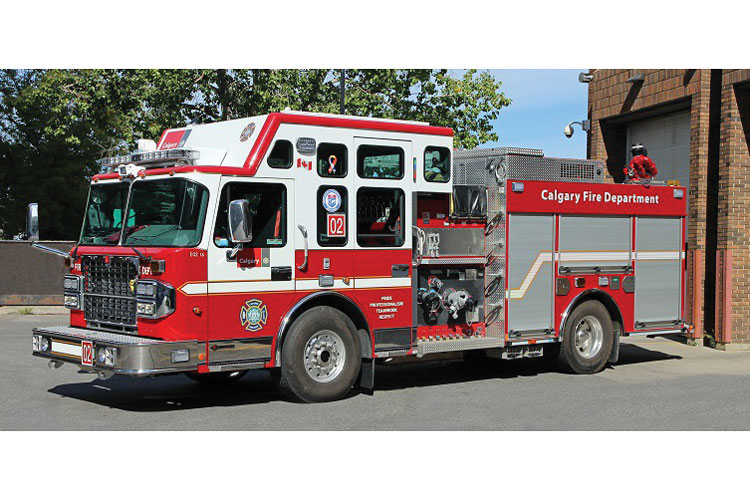 |
| 3 One of 16 Smeal pumpers on Spartan Gladiator chassis delivered to Calgary, Canada’s third largest city. It features an enclosed top-mount pump panel, 2,000-gpm Waterous pump, onboard foam system, Akron 3440 DeskMaster electric monitor, and Smeal’s Green Power auxiliary power unit. Calgary’s entire fleet has been supplied by Safetek. |
Canadian manufacturers do not build their own cabs and chassis or aerial devices. Only one advertises a nationwide distribution network. The rest appear to be regional builders mainly selling factory direct. Manufacturers that list dealers only show a few. One manufacturer claiming to be Canada’s largest lists nine “locations” in Canada and three in the United States, with a mix of factory-direct and dealer contacts. Hence, importing and exporting fire apparatus is a two-way street.
Fewer than a dozen American apparatus manufacturers indicate local representation in Canada. Several state sales are handled factory direct. Others only list a few dealers in the country. Some American manufacturers have aligned themselves with Canadian apparatus manufacturers, allowing the local dealers to represent both product lines in Canada. One American apparatus manufacturer supplies a custom cab and chassis to a Canadian builder, which builds the back end. More on importing apparatus later.
The Canadian Marketplace
The Canadian Association of Fire Chiefs’s (CAFC) Web site states, “Founded in 1909, the Canadian Association of Fire Chiefs is an independent, nonprofit organization with a voluntary membership representing approximately 3,500 fire departments across Canada.” One dealer claims that in 2012 the CAFC reported 3,708 fire departments. A National Fire Protection Association (NFPA) January 2016 research paper states that in 2016 there were 27,198 fire departments in the United States. Canada has less than 13 percent of the fire departments the United States has in a land mass slightly larger. It is important to note that both the NFPA and CAFC figures rely on the voluntary reporting of participants. Most of the fire departments are in the provinces bordering the United States – mainly in Quebec, Ontario, British Columbia, and Alberta, which is where about 85 percent of the Canadian population resides.
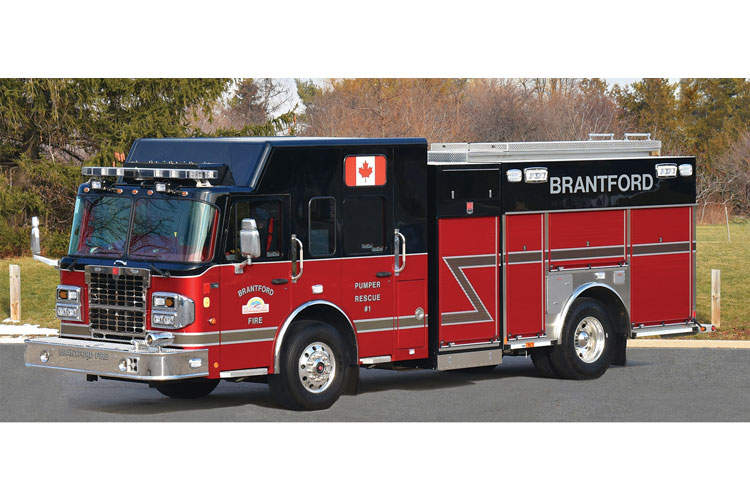 |
| 4 In the province of Ontario, the Brantford Fire Department’s Smeal custom rescue-pumper is on a Spartan Metro Star chassis with a 1,750-gpm single-stage pump and a 540-gallon tank. The pump panels are enclosed behind roll-up doors. |
The 2013-2015 NFPA Fire Survey of Canada shows 169,800 total firefighters with about 15 percent career and 85 percent volunteer compared to 31 percent career and 69 percent volunteer in the States. The International Association of Firefighters – Canada (IAFF) Web site shows 86 percent of career firefighters in Canada are IAFF members.
Providing nationwide sales and service coverage in Canada is challenging for manufacturers and dealers alike. It is especially so, but not entirely impossible, when the entity covers the entire country. It is more so when a dealer does not represent a domestic manufacturer. Large sparsely populated areas and extreme distances hinder the selling process. In the United States, it’s about 3,200 road miles from Portland, Maine, to Portland, Oregon. In comparison, it is 5,400 road miles from Inuvik in Canada’s Northwest Territories to Sydney, Nova Scotia, in the east – an almost 70 percent greater distance. Making back-to-back sales calls can be time-consuming and expensive.
Safetek Emergency Vehicles, Ltd.
According to a company spokesperson, “Safetek is a leading provider of fire and emergency vehicles, parts, and service. Across Canada, Safetek represents industry-leading brands including Spartan Chassis, Spartan Emergency Response, Smeal Fire Apparatus, Ladder Tower Corporation, US Tanker, and SVI Trucks.” It is my opinion that Safetek is the largest dealer in Canada. Noteworthy is that Safetek markets fire apparatus that are imported from the United States. And, Safetek covers the entire country.
Owner and founder John Witt founded Safetek in 1993 as a sole proprietorship in Abbottsford, British Columbia. His prior experience in the fire service industry includes serving as sales manager for Pierreville Fire Trucks from 1980 to 1985. One of Witt’s objectives was to “set out to introduce the product line, especially aerials, to the marketplace outside of Quebec by providing detailed performance specifications and endeavor to improve the reputation of the company.” Pierreville built its own aerial ladder that was based on the design of the aerial manufactured by the original Thibault family company.
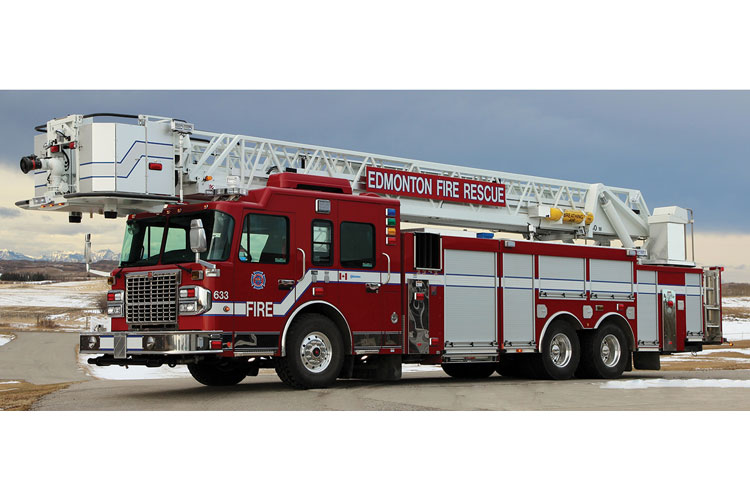 |
| 5 One of two Smeal 100-foot rear-mount platforms on Spartan Gladiator chassis delivered to Edmonton Fire Rescue in Alberta. They have Hale Qmax 2,250-gpm pumps, 300-gallon tanks, and dual Class A and Class B foam systems. The pump houses are also protected by roll-up doors. Edmonton is another department whose entire fleet was procured through Safetek. |
From 1985 to 1993, Witt served as Firelifts sales manager for Bronto Skylift North America Ltd. According to Witt, he “Introduced the Bronto Skylift telescopic articulating firefighting platforms to the North American marketplace and pioneered its development to meet both the NFPA and Underwriters Laboratories of Canada (ULC) standards and meet the needs of the fire departments in North America.” He started Bronto Skylift North America in 1985 and marketed directly to fire departments. The Bronto was a Finnish import, and Anderson Engineering, a Canadian builder, did the bodywork.
Witt expanded Safetek with a second sales and service center in Mississauga, Ontario. Expansion continued with the acquisition of Profire Emergency Equipment Inc. in 2008, further enhancing after sales service and parts distribution from coast to coast. Safetek Emergency Vehicles currently employs 30 people in two locations in Canada and has authorized service providers across the country.
 |
| 6 Located north of Toronto, Vaughan Fire & Rescue Services runs these two Smeal custom side-mount pumpers on Spartan Metro Star chassis with Waterous CSU 2,250-gpm single-stage pumps, powered treadplate hosebed covers, and the Green Power SG-09 systems. |
Witt says, “We currently occupy approximately 18,000 square feet in our Abbotsford, British Columbia, location, which houses our sales, administration, service, warranty, parts, and fabrication divisions. We have outgrown our current facility and are currently planning the design/build of a new 30,000-square-foot customer service center in Abbotsford to better manage our growing business and serve our growing list of customers. We also have a 6,000-square-foot customer service center in Ontario. The Canadian market runs the gamut from large aerial platforms with high-capacity pumps and onboard foam systems that serve larger urban cities to all-wheel-drive wildland type apparatus suitable for off-the-road terrain found in many suburban and rural communities.”
Witt continues, “Most (Canadian) fire apparatus dealers are local or regional and carry one or maybe two brands. What makes Safetek unique and different from our competitors is that we are a national dealer as opposed to representing a local or regional area. Our competitors typically represent a defined area within Canada, such as Western Canada or Ontario Province.”
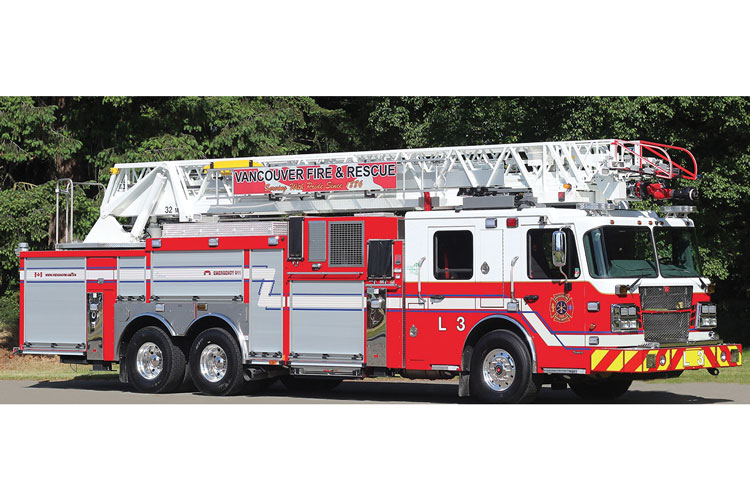 |
| 7 Vancouver Fire & Rescue Services Ladder 3 is one of an order of 10 Smeal 105-foot rear-mount aerial quints on the Smeal Sirius chassis. It features a Waterous CMUC20 2,250-gpm pump, 400-gallon tank, compressed-air foam system, diagrammatic overlay pump panels, and the Smeal SG09 system. |
Witt adds, “Safetek is the only national full-service emergency service provider in Canada. We supply fire-rescue apparatus and vehicles, related equipment, and parts and service coast to coast to coast (Atlantic to Pacific to Arctic Oceans). We have delivered fire-rescue vehicles to departments in all 10 Canadian Provinces and each of the three Territories, including the town of Inuvik in Canada’s high Arctic at 68 degrees north latitude.”
Witt concludes, “Aluminum has been the most common body material for many years, but with the advent of the liquid road deicer, we are seeing a growing trend toward stainless steel, especially in Eastern Canada. Rescue-pumper configurations are as popular in Canada as they are in the States. Many Canadian municipalities are multihazard response agencies and face a similar challenge to do ‘more with the same,’ which has resulted in the rise in popularity of rescue-pumper configurations. Many departments are not able to purchase and staff a dedicated heavy rescue vehicle. Many of the major city and urban fire departments still purchase traditional engines, though Vancouver has recently purchased (from Safetek) 14 engines, and five of them are rescue-engines.”
CAN/ULC-S515-13 and NFPA 1901
Witt says the Underwriters Laboratories of Canada Standard for Automobile Fire Fighting Apparatus (CAN/ULC S515-13), Third Edition, is the most current version. He continues, “The standard reflects the needs of Canadian fire departments and includes unique Canadian requirements, such as road performance test requirements that specify balance and weight distribution, for the safety of both firefighters and the general public.”
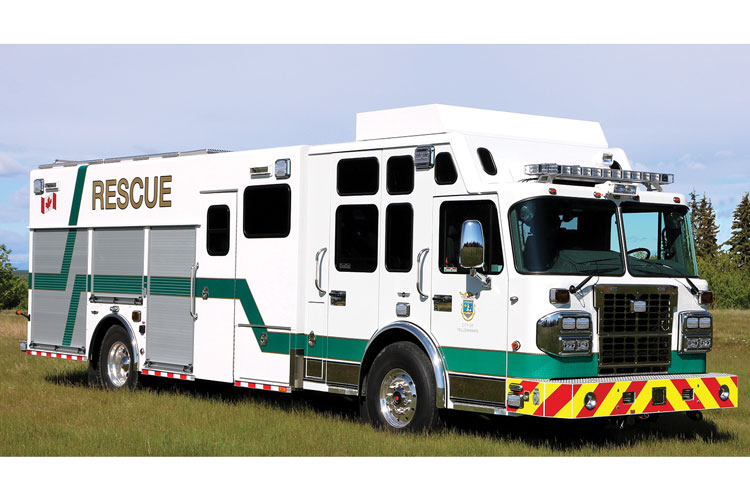 |
| 8 Safetek delivered an SVI custom rescue built on a Spartan Metro Star chassis to the City of Yellowknife’s Fire Division in Canada’s Northwest Territories. The rig has a 22-foot-long body and a unique flush-mount side entrance door. |
Asked about some of the differences between NFPA 1901, Standard for Automotive Fire Apparatus, and the CAN/ULC S515-13, Witt responds, “All certified firefighting apparatus are certified by an independent third-party certification organization accredited by the Standards Council of Canada. As an independent and reputable third-party safety testing and certification organization, ULC provides a thorough and unbiased product evaluation. The ULC certification means that a product or system has been evaluated, tested, and found compliant with applicable Canadian standards. A CAN/ULC-S515-04 inspection is done in person by a representative of the ULC and includes a review of construction methods, operator and passenger safety, electrical performance tests, road tests, pump performance, weight (full and empty), and acceleration and braking tests. An apparatus must pass all tests at the factory before a ULC plate is issued. Manufacturers cannot claim to be in compliance with ULC standards but are subject to ongoing audits. While the NFPA administers the process and establishes rules to promote fairness in the development of consensus, it does not independently test, evaluate, or verify the accuracy of any information or the soundness of any judgments contained in its codes and standards. The NFPA has no power, nor does it undertake to police or enforce compliance with the contents of this document. Nor does the NFPA list, certify, test, or inspect products, designs, or installations for compliance.
 |
| 9 One of three Smeal side-mount pumper-tankers Safetek delivered to Surrey Fire Services in British Columbia. Mounted on Freightliner commercial chassis, they feature Darley PSM 1,500-gpm pumps, PuriFire 4S10F Darley water purification systems, and 2,000-gallon booster tanks. |
“While I believe there is an intent to ‘harmonize’ the NFPA/ULC standards to the extent possible, there are currently no Canadian representatives serving on the Technical Committee on Fire Department Apparatus. I was the only Canadian serving on the NFPA 1901 committee a few years ago and currently serve on the ULC S515 Apparatus Standards Committee. There are approximately 400 apparatus sold in Canada, and I’d say more than 95 percent require NFPA as well as ULC standards compliance.”
Canadian Environmental Protection Act (CEPA1999)
The Canadian Parliament passed the Canadian Environmental Protection Act in 1999 that, according to Canada’s Justice Laws Web site, is “an Act respecting pollution prevention and the protection of the environment and human health in order to contribute to sustainable development.” Whether by decree, influence, or on their own, local and Provincial level governments have been adopting “sustainability initiatives,” one of which is incorporating low-emission vehicles and equipment in their municipal fleets while successfully meeting operational needs.
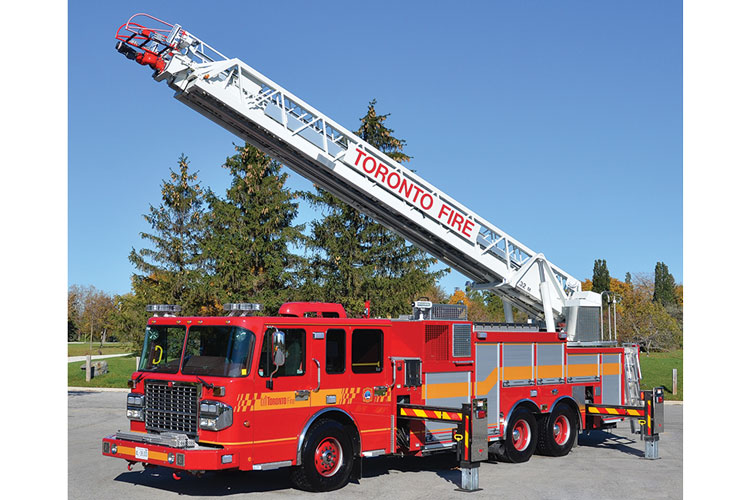 |
| 10 One of four Smeal 105-foot heavy-duty quints recently delivered to Toronto Fire Services. It features a Waterous 2,250-gpm, 500-gallon tank, and the Green Power system. |
According to Witt, Safetek was a pioneer in offering and supplying fire apparatus that support the environmental sustainability strategies of many communities across Canada. The system supplied is called Green Power Anti-Idle Technology and is provided on Smeal fire apparatus. He elaborated that the technology was introduced in 2011, and Safetek currently has either delivered or has on order 100 pieces of apparatus with the Green Power technology. According to its Web site, Safetek is making Canada green one truck at a time.
In fairness to other dealers, several apparatus manufacturers in the United States besides Smeal offer their own systems that reduce fuel consumption and lower carbon emissions.
NAFTA
I asked Witt if Safetek, representing an American apparatus manufacturer, has to contend with Canadian tariff and/or import laws. His reply, “Under the North American Free Trade Agreement (NAFTA), there are no tariffs on imported goods entering Canada originating from the United States. However, all fire-rescue vehicles imported into Canada are subject to a Federal Goods and Services Tax of five percent on the sale price that is collected on all imported vehicles. All vehicles must meet the requirements under the Canadian Motor Vehicle Safety standards. They must complete the Registrar of Imported Vehicles inspection within 45 days from the date of import. There is an air conditioning excise tax of $100, and recall clearance documents verify that any defects identified by the manufacturer as a potential safety risk to the vehicle’s operator, occupants, and public at large have been corrected.”
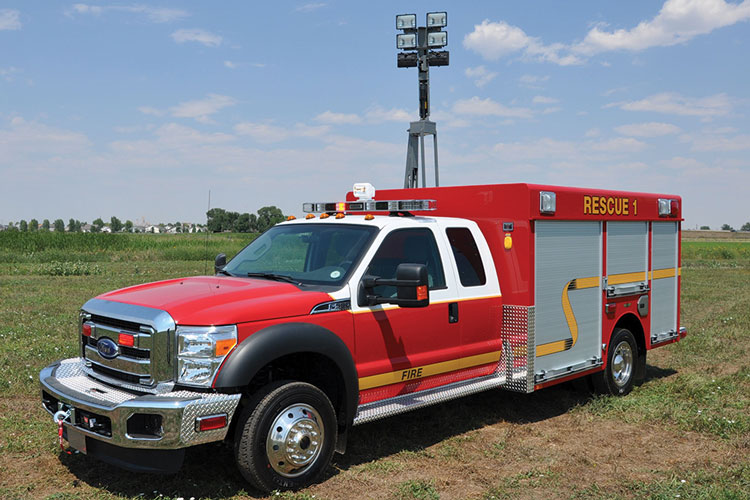 |
| 11 Safetek delivered an SVI light rescue with a light tower built on a Ford F550 4×4 chassis for the Fredericton (New Brunswick) Fire Department. |
Specifications and Bidding
“Many Canadian municipalities attempt to write and release performance specifications. However, most specifications are ‘prescriptive’ specifications that explicitly identify the materials and work methods or procedures a manufacturer should use to complete the work,” says Witt. “Many specifications are written around a preferred manufacturer – usually with the help of the local vendor.”
“A request for proposals (RFP) is one of the most common solicitation strategies used by Canadian municipalities to procure fire-rescue vehicles. The goals of the RFP process is to support the principles of fair, open, and transparent procurement and to ensure compliance with applicable trade agreements and common law. Tenders, what the U.S. refers to as a bid and request for quotations, are far less common purchasing tools used by Canadian municipalities for acquiring fire-rescue vehicles. Cooperative purchasing programs such as the Houston-Galveston Area Council are less common in Canada, alhough we have pioneered the single/sole source or ‘tag on’ process and multiyear contracts very successfully with many fire departments in both the Metro Toronto area and in British Columbia and Alberta.”
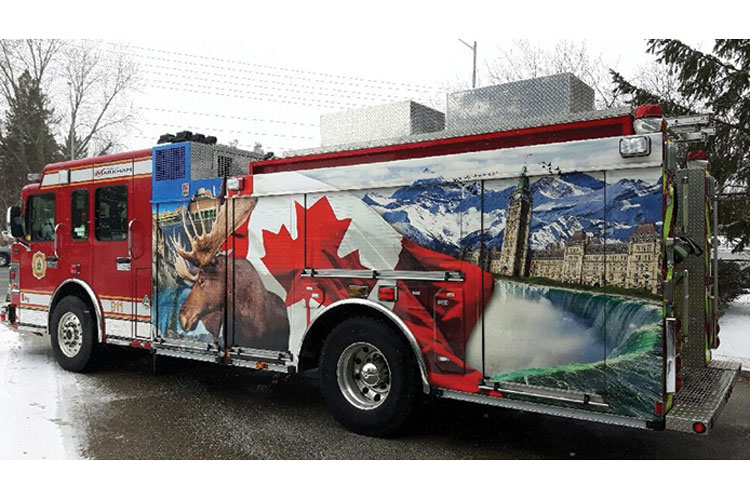 |
| 12 The Markham (Ontario) Fire and Emergency Services Green Power-equipped 2016 Smeal custom pumper. Built on a Spartan Metro Star chassis, this truck features a 500-gallon water tank and a Hale Qmax 2,250-gpm pump. The custom graphics recognize the history of the department and some of Ontario’s landmarks as part of 2017’s year-long celebration of Canada’s 150th birthday. |
Witt says, “Over the past few of years, we have been successful in securing several major and multiyear contracts from some of Canada’s largest fire departments, including Toronto, Vancouver, Calgary, and Edmonton. We have delivered more than 1,200 fire-rescue vehicles since 1993 to fire departments across Canada. Safetek’s 100th order for the Green Power technology was with Edmonton’s (Alberta) recent purchase of nine custom pumpers. Vancouver, British Columbia, recently placed into service 24 Green Power-equipped apparatus, including 10 quints, nine custom engines, and five custom rescue-engines.”
Witt says Safetek’s motto and pledge is: “Serving those who keep our communities safe.” It appears Safetek is doing just that throughout the vast expanses of Canada.
BILL ADAMS is a member of the Fire Apparatus & Emergency Equipment editorial advisory board, a former fire apparatus salesman, and a past chief of the East Rochester (NY) Fire Department. He has 50 years of experience in the volunteer fire service.
 |
| 13 The Markham (Ontario) Fire and Emergency Services Green Power-equipped 2016 Smeal custom pumper. Built on a Spartan Metro Star chassis, this truck features a 500-gallon water tank and a Hale Qmax 2,250-gpm pump. The custom graphics recognize the history of the department and some of Ontario’s landmarks as part of 2017’s year-long celebration of Canada’s 150th birthday. |

